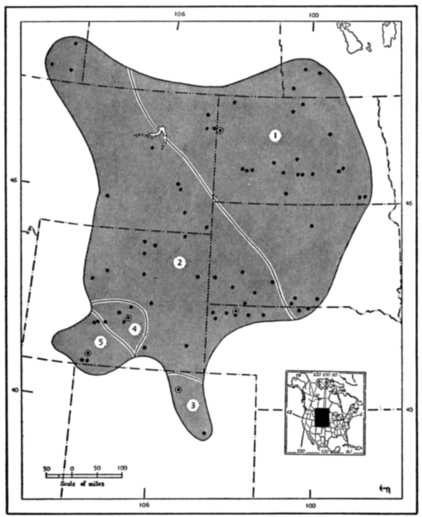Geographic Distribution of the Pocket Mouse,
Perognathus fasciatus
BY
J. KNOX JONES, JR.
University of Kansas Publications
Museum of Natural History
Volume 5, No. 29, pp. 515-526, 7 figures in text
August 1, 1953
University of Kansas
LAWRENCE
1953
University of Kansas Publications, Museum of Natural History
Editors: E. Raymond Hall, Chairman, A. Byron Leonard,
Robert W. Wilson
Volume 5, No. 29, pp. 515-526, 7 figures in text
August 1, 1953
University of Kansas
Lawrence
1953
PRINTED BY
FERD VOILAND, JR., STATE PRINTER
TOPEKA. KANSAS
1953
24-7673
Geographic Distribution of the Pocket Mouse,
Perognathus fasciatus
BY
J. KNOX JONES, JR.
In his "Revision of the pocket mice of the genus Perognathus," Osgood(1900:18-20) reviewed the distribution, as then known, of Perognathusfasciatus and recognized two geographic races—Perognathus fasciatus[fasciatus] Wied-Neuwied in eastern Montana and Wyoming and adjacentparts of North and South Dakota, and Perognathus fasciatus infraluteusThomas, known only from the type locality at Loveland, Larimer County,Colorado. Later, Cary (1911:61) described Perognathus fasciatus litusas a pale subspecies occurring in the lower Sweetwater Valley andadjacent parts of the Red Desert of south-central Wyoming. After 1911 noimportant taxonomic contributions dealing with Perognathus fasciatusappeared.
In studying the kinds of pocket mice known from Nebraska, I examinedthirteen specimens of P. fasciatus from the northwestern part of thestate which did not agree satisfactorily with the descriptions of anyknown subspecies of fasciatus. This impelled me to examine materialfrom the entire range of P. fasciatus. This examination revealed that:(1) Perognathus callistus Osgood, heretofore considered to be a fullspecies, should be reduced to subspecific rank under P. fasciatus; and(2) specimens from eastern Wyoming and adjacent parts of Montana, SouthDakota and Nebraska represent an heretofore unrecognized subspecies.Further investigation, however, revealed that Perognathus flavescensolivaceogriseus Swenk, described from northwestern Nebraska (Swenk,1940:6), is not flavescens but actually fasciatus. Since thespecimens on which Swenk's description was based were taken within therange of this newly recognized subspecies, and since my examination ofthe holotype shows it to be of the species Perognathus fasciatus, thesubspecific name olivaceogriseus is available.
The subspecies of P. fasciatus are most easily distinguished by colorof pelage, in which there is a general cline from northeast (dark) tosouthwest (pale). Cranially, the subspecies are less distinct. Theskulls of P. f. callistus can be distinguished from those of the othersubspecies by several differences; however, among the other foursubspecies, only minor cranial differences are evident. Individualvariation was found to be greater than secondary sexual variation.
 Fig. 1. D
Fig. 1. D